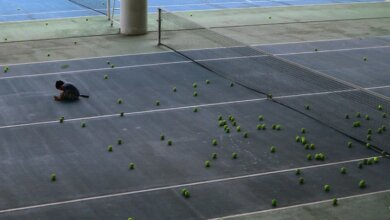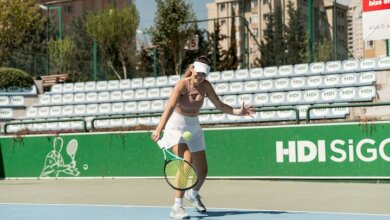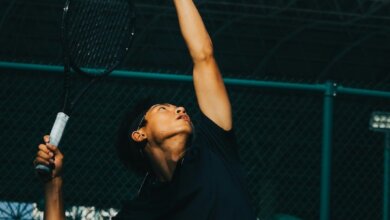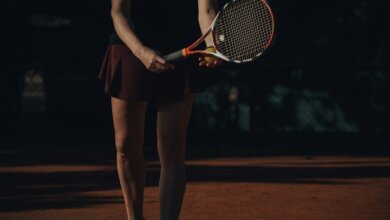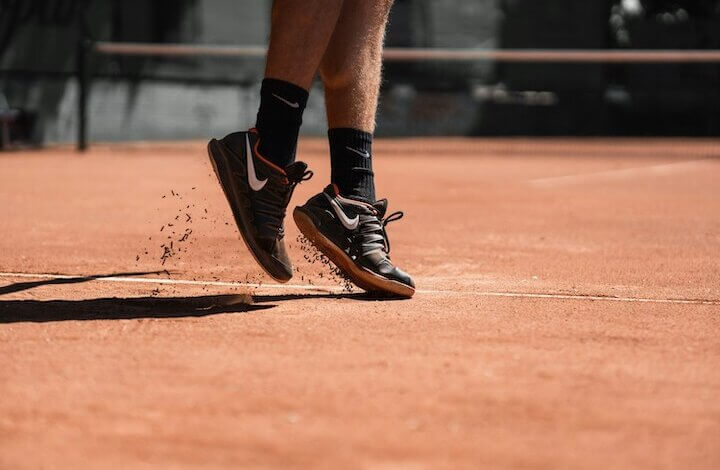
We're an affiliate
We hope you love the products we recommend! Just so you know, we may collect a share of sales or other compensation from the links on this page. Thank you if you use our links, we really appreciate it!
Ever wonder what goes through a pro player’s mind before stepping onto the court? You see them on TV, walking out calm, collected, and ready. But underneath all that poise, there’s usually a deeply personal system in place — a string of rituals that helps them tune out the noise and lock in.
Rituals pro players use before a match might seem odd at first. Like, why would someone always place their water bottles at the same angle before every match? Or bounce the ball five times before every serve — not four, not six, but five exactly. It’s not about magic. It’s about control, focus, and comfort. You’d be surprised how many top players do the same weird little things every single time.
Today, I want to show you what’s going on behind the curtain — why these routines exist, what some of the best players in the world do, and how you might actually use this idea in your own life, even if you’ve never picked up a tennis racket.
Table of Contents
Key Takeaways
- Rituals pro players use before a match are personal habits that help them stay focused and calm.
- These rituals build rhythm and confidence, especially under pressure.
- They’re not magical — they’re mental.
- You can create your own routine, even if you’re just starting out.
- Small patterns = big mental clarity.
- Even casual players and non-athletes can benefit from rituals.
- The best rituals are the ones that help you feel like yourself — ready, present, and grounded.
Why Tennis Players Rely on Rituals
Let’s be real — tennis is a lonely sport. You don’t get a coach yelling plays from the sidelines. Once you’re on that court, it’s just you, your racket, and your thoughts.
That’s why rituals pro players use before a match matter so much. They give the player something familiar to hold onto. A way to breathe. A rhythm to follow.
Think about it like this: ever tied your shoes a certain way before something important? Or played a song to get you in the zone? That’s your version of a pre-match ritual. Now imagine the pressure of a packed stadium and millions watching you live. You’d want something grounding too, right?
These rituals create structure. And structure breeds calm.
But it’s more than calm — it’s identity. These habits remind players who they are when the nerves creep in. It’s a way of saying, “This is me. I’ve been here before.”
And that’s not just helpful. That’s powerful.
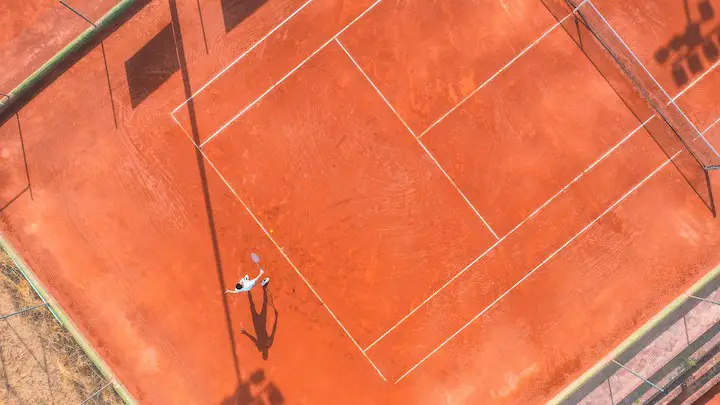
Rafael Nadal’s Rituals: Control in Chaos
You can’t talk about rituals pro players use before a match without talking about Nadal. His routines are legendary.
Here’s what he does:
- Places his water bottles at precise angles near his bench — labels facing a certain way.
- Jumps at the net during the coin toss.
- Adjusts his hair, his shorts, and wipes his face the same way before every serve.
- Walks to his chair in the same specific pattern between changeovers.
From the outside? It looks obsessive. But to him? It’s rhythm. It’s how he tells his body and mind, “We’ve done this a hundred times. We’re ready.”
He once said it himself — the routine isn’t superstition. It’s about keeping things in order. When everything else feels shaky, this is what stays steady.
He’s a warrior. And like any warrior, he sharpens his blade the same way before every fight.
Also Read: Powerful Fix: How to Fix Tennis Elbow With Technique (Not Just Painkillers)
Serena Williams’ Repeated Rituals
Serena’s got her own list.
- Same socks for an entire tournament.
- Five ball bounces before every serve.
- Wears specific gear combinations depending on how she feels.
- Avoids stepping on court lines when walking.
These small habits keep her anchored. They bring a sense of familiarity, no matter what city or surface she’s playing on.
It’s kind of like when you wear your lucky shirt on a big day. It doesn’t guarantee success, but it helps you walk in with confidence. That’s what her rituals do.
When she’s repeating those actions, she’s not thinking about pressure or noise. She’s locked in.
And that’s the point. Rituals eliminate distractions.
Novak Djokovic’s Inner Quiet
Novak is a bit different.
He leans into silence and stillness. You’ll often see him meditating before matches — eyes closed, breathing deep, locking into his body.
His rituals are subtle:
- Long stretches with precise breath control.
- Standing still and breathing before walking onto the court.
- Visualizing entire points before they even begin.
- Eating the same light snacks exactly 90 minutes before a match.
It’s not flashy. But it’s powerful. For him, the ritual is less about repetition and more about presence. And that still counts as one of the rituals pro players use before a match — maybe even one of the most effective ones.
He doesn’t try to block out the noise. He just gets quieter than it.
Roger Federer’s Precision Rituals
Federer might seem casual, but he’s methodical too.
- Arrives exactly two hours before every match.
- Eats the same pre-match meal — pasta with light sauce.
- Warms up with specific drills, always in the same order.
- Has a pre-match conversation with his coach that’s part strategy, part mental ease.
It’s almost like a reset button. He’s not guessing. Neither is he scrambling. He’s following a map that’s worked for years.
Federer’s rituals are simple. They don’t scream for attention. But they do something quietly important — they clear away uncertainty. And when you clear that out, all that’s left is focus.
His calm isn’t natural. It’s built.
More Rituals From Other Pros
Let’s not forget others.
- Andy Murray always wears his wedding ring on his shoes during matches.
- Dominic Thiem listens to the same playlist every time he warms up.
- Coco Gauff journals before big matches — a few sentences about how she wants to feel on court.
- Nick Kyrgios? He might not seem like the ritual type, but even he uses music and pre-match isolation to flip a switch internally.
Some players pray. Others visualize. Some stay silent for hours. All of it is valid. All of it counts.
It’s about tapping into something familiar in a very unfamiliar place. That is why the rituals pro players use before a match are so interesting.
Superstition vs. Intentional Ritual
Let’s talk about the difference.
- A superstition feels like: “If I don’t do this, something bad will happen.”
- A ritual feels like: “When I do this, I feel prepared.”
See the shift?
That’s why I love the idea of rituals pro players use before a match. It’s not about luck. It’s about preparation. They don’t believe the routine wins the match. They believe it gets them ready to win it.
So no — these aren’t magical spells. They’re mental anchors.
And once you look at them that way, they stop feeling silly. They start feeling smart.
Do These Rituals Actually Work?
Here’s what I think.
The rituals pro players use before a match? The water bottles? The socks? The bounces? None of those things do anything on their own.
But they create consistency. And that builds trust in yourself.
Imagine walking into a loud room. If you’ve got a song in your head, you won’t hear the noise as much. That’s what a ritual is. It drowns out the noise, the nerves, the doubt.
It’s like telling your body: “We know what this is. Let’s go.”
So yeah — I think they work. Not because of magic. But because of mindset.
And if it works for the pros at the highest level? It can definitely work for you too.
You Can Create Your Own Pre-Match Ritual
You don’t have to be Nadal or Serena to have a ritual.
If you play casually, or even if you’re just starting out, you can still build something that gets you locked in.
Here are a few ideas:
- Take 3 deep breaths before stepping onto the court.
- Bounce the ball a specific number of times.
- Say something to yourself before every serve: “Breathe. Focus. Move.”
- Pack your gear in the same order every time.
- Eat a light meal that feels good in your body, every time.
- Tie your laces a certain way and tap your racket twice on the ground.
These might sound small. But they build muscle memory. And that leads to confidence.
Plus, your mind loves patterns. When you give it a pattern before something intense, it calms down.
Your body remembers. It responds.
Rituals Aren’t Just for the Court
Honestly? This idea works outside tennis too.
Job interview? Big speech? Important test?
Build a small ritual. Wear something that makes you feel confident. Listen to a specific playlist. Stretch. Say a phrase to yourself. Anything that helps you focus.
I’ve done it too. And I’m telling you, it works.
If you treat the moment like it matters, and you give yourself space to settle in, everything feels lighter. It’s not about perfection. It’s about presence.
Rituals are for athletes. But they’re also for humans.
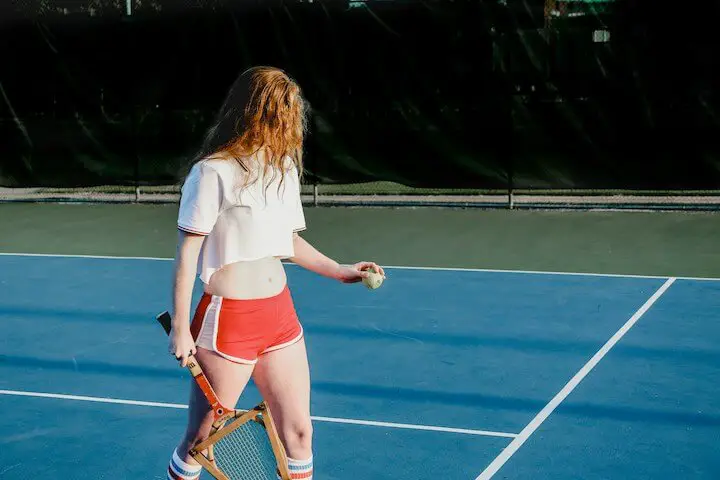
Conclusion
So here’s what I hope you take from this.
Rituals pro players use before a match might look odd — even silly — from the outside. But on the inside? They’re a way to stay grounded when everything else feels loud.
You can create your own. Whether you play tennis or not. Whether you’re stepping onto a court or into a meeting.
Build a small moment that feels like yours. Something that reminds you: you’re ready.
That’s all a ritual really is.
Frequently Asked Questions
Do all tennis pros have a pre-match ritual?
Most of them do. Some are super detailed, like Nadal’s. Others are quiet and subtle, like Djokovic’s. But nearly every pro has something that helps them feel grounded before a match.
Are rituals the same as superstitions?
Nope. Rituals are about focus and control. Superstitions are about fear and luck. One helps you stay present. The other can make you feel anxious.
Can beginners use rituals too?
Absolutely. In fact, they can help you even more. If you’re nervous or unsure on the court, having a small routine can help you stay calm and focused.
What’s one simple ritual I can start using before my matches?
Try this: take a few deep breaths, bounce the ball a few times, and say something calming to yourself. You’ll feel more in control right away.
What happens if a player’s ritual gets interrupted?
Some players struggle with it. Others adapt. The goal isn’t to be perfect — it’s to be present. A good ritual helps you recover quickly, not panic.
Can a bad ritual hurt your game?
If it becomes a superstition, yes. If you believe something bad will happen without it, that can build anxiety. But a ritual grounded in preparation? That helps.

